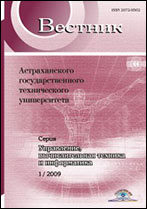|
|
Vestnik of Astrakhan State Technical University. Series: Management, Computer Sciences and Informatics, 2014, Number 4, Pages 103–111
(Mi vagtu349)
|
 |
|
 |
This article is cited in 2 scientific papers (total in 2 papers)
SOCIAL AND ECONOMIC SYSTEMS MANAGEMENT
Setting up of schedules in the time planning tasks
A. S. Dobrynin, S. M. Kulakov, R. S. Koynov, A. V. Grachev
Siberian State Industrial University
Abstract:
The most important condition in the scheduling of the project activity is keeping the set time limits, which are linked to periodic intervals of work time. Classic JSSP (Job Shop Scheduling Problem) tasking did not pay enough attention to periodic intervals schedules of most organizations and enterprises. Formulation and solution of the planning problem presented in this article involves the introduction of a minimum length of time that allows the flexibility to describe the structure of periodic time constraints. The article deals with the time shift algorithm used to obtain a precise schedule in terms of periodic time intervals. Solution of this problem involves two steps: the first step is to set up a continuous schedule (Gantt chart), the second comprises its subsequent periodic adjustment to the time constraints of an arbitrary shape. The second step is used to solve the problem of shift algorithm, the computational complexity of which depends on the minimum amount of time and its dimension (duration of the project). Algorithm testing within the model-algorithmic complex on the graphs shows insignificant increase in computational complexity with a significant increase in the volume of initial data. Thus, the algorithm has a data application prospects in large-scale industrial systems of scheduling. The considered problem of scheduling is urgent for companies and organizations involved in developing and implementing the projects, IT service providers, etc. The submitted mechanisms and techniques can be used in the development of planning subsystems in various branches of science and technology (production, transportation, design-process activities).
Keywords:
labeling, schedule, IT-service, job shop schedule, time constraints, service management.
Received: 16.05.2014
Revised: 25.06.2014
Citation:
A. S. Dobrynin, S. M. Kulakov, R. S. Koynov, A. V. Grachev, “Setting up of schedules in the time planning tasks”, Vestn. Astrakhan State Technical Univ. Ser. Management, Computer Sciences and Informatics, 2014, no. 4, 103–111
Linking options:
https://www.mathnet.ru/eng/vagtu349 https://www.mathnet.ru/eng/vagtu/y2014/i4/p103
|

| Statistics & downloads: |
| Abstract page: | 102 | | Full-text PDF : | 48 | | References: | 32 |
|




 Contact us:
Contact us: Terms of Use
Terms of Use
 Registration to the website
Registration to the website Logotypes
Logotypes








 Citation in format
Citation in format 
